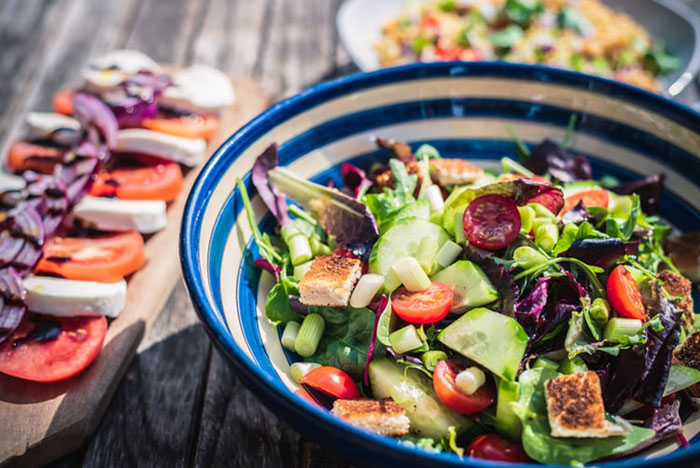 Feature Image by Jez Timms
Feature Image by Jez Timms
From Whole30 to Keto and everything in between, there seems to be an eating plan that works for everybody. People who follow food combining principles believe that when you eat the wrong foods together, it can impact your digestion and cause you to feel sick or gain weight. On the other hand, eating the right food combinations can boost your energy, help you lose weight in a healthy way, and improve your overall health.
Though there are different variations for food combining, most of the general rules are the same. To learn more, we talked to celebrity nutritionist and author Natalia Rose to get the scoop on the basics of food combining.
Choose a protein or starch for each meal – but not both!
Rose says that the concept of food combining is based on the idea that fruits, proteins, and starches digest at different times in the body. When you combine foods that don’t digest well together, you might experience gas, bloating, indigestion, or weight gain. Luckily, there are plenty of tasty options that’ll still leave you feeling satisfied.
“One of my favorite ways to order at a restaurant is a big salad (double order at times) with lemon and olive oil, all the veggie sides as a main, and one grain, whether it’s gluten-free pasta, quinoa, or a side of rice. If you’re a carnivore, you can keep your grass-fed steaks, just pair them with non-starchy vegetables like spinach or broccoli and nix the potato.”
Plan your meals (and day) from light to heavy
“Within the principles of food combining, we digest light foods the fastest and heavier foods slowly,” Rose explains. “To help digestion and prevent gas and bloating, we structure our meals light to heavy. Think a salad before every cooked meal, and no fruit at the end of a meal since it’s light. Eat your lightest in the morning, like a fresh green juice or fruit salad, [and] have these alone and on an empty stomach.”
Know what’s neutral
Rose let us know that there is a heap of healthy foods that are “neutral,” which means you can pair them with anything. Her list includes all leafy greens, celery, cucumber, garlic, onions, broccoli, carrots, parsnips, spaghetti squash, tomatoes, eggplant, cauliflower, beets, zucchini, yellow squash, peppers, oils, and grass-fed butter.
Pair properly for best results
Both starches and proteins can be combined with neutral veggies, but not with each other or with nuts. You can also eat starches and proteins with legumes, chickpeas, lentils, beans, and sweet peas. When it comes to nuts or dried fruit, Rose says to combine them with each other or with neutral vegetables.
Don’t lose sight of the big picture
“Know that food combining alone isn’t the answer,” says Rose. “Partner this diet with plenty of sweating, circulation, sun, and movement to feel your best.”
xx, The FabFitFun Team
Struggling with bad digestion? It might be what you’re eating. Here are five foods to avoid if you have bad digestion.





